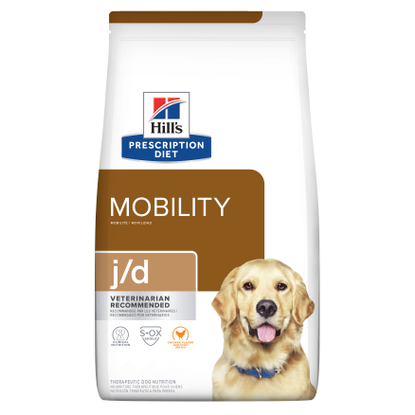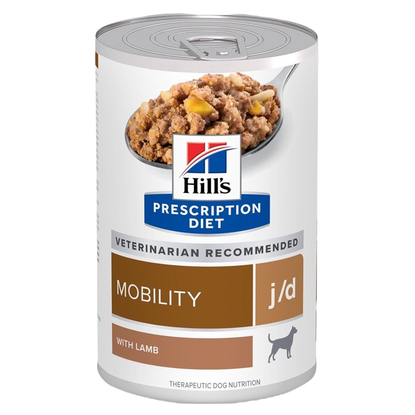Dog Hip Pain: Signs and How to Help

All featured products are chosen at the discretion of the GreatPetCare editorial team and do not reflect a direct endorsement by the author or reviewer.
Hip pain is a very common problem encountered in dogs that can significantly impact their quality of life. Whether caused by hip dysplasia, osteoarthritis, or other conditions, dogs experiencing hip pain may struggle with everyday activities like walking, sitting, and playing.
It’s crucial for pet parents to recognize the signs of hip pain in dogs in order to provide timely care.
In some cases, switching to a specialty diet, like Hill’s Prescription Diet j/d, can help maintain healthy joints and promote mobility. In other cases, more urgent interventions may be necessary.


In this article, you will learn what causes hip pain in dogs, signs of hip pain to recognize, when to seek help from your veterinarian, and how you can help your dog with hip pain at home.
Causes of Hip Pain in Dogs
While there are many possible causes of hip pain in dogs, the most common cause is due to hip dysplasia. Hip dysplasia is found in up to 75 percent of certain breeds of dogs, such as the English Bulldog, but is also present in a wide variety of dog breeds (1).
Hip dysplasia is a developmental disorder characterized by an abnormal ball and socket hip joint, in which the head of the femur (ball) slips out of the acetabulum of the pelvis (socket). This creates significant pain and instability of the hip and will eventually lead to hip osteoarthritis—commonly referred to as arthritis—later in life. Hip arthritis is a chronic condition caused by the gradual deterioration of the cartilage in the joint leading to bone-on-bone contact, scarring of the joint, joint pain, and loss of range of motion in the hip joint.
While hip dysplasia is the most common cause of hip arthritis in dogs, hip arthritis can also be caused by previous injuries to the joint, joint infections, and being overweight or obese. Dogs who are overweight or obese have excess forces applied to their joints and, over long periods of time, this can cause increased wear and tear on joint cartilage and increased joint inflammation, leading to the development of arthritis.
Whether hip pain is acute or chronic can give a clue as to its cause. Hip dysplasia and hip arthritis will typically cause chronic hip pain, which comes on gradually and does not go away. Meanwhile, acute hip pain is often more severe, comes on suddenly, and will often resolve if the underlying cause is treated. Causes of acute hip pain include muscle strains affecting the iliopsoas muscle (a hip flexor), pelvic or femoral fractures, and hip luxations (dislocations).
7 Signs of Hip Pain in Dogs

Here are some possible signs of hip pain in dogs to watch for:
Limping
Dogs with hip pain will often limp in one of their back legs. The limp may come and go and may become more pronounced after strenuous exercise or after lying down for long periods of time.
Difficulty or slowness to stand up or lie down
Because the hips have to significantly extend to allow a dog to stand up and have to flex to allow them to lie down, dogs with hip pain often have a hard time or are reluctant to stand and lie down. You will also likely notice that dogs with hip pain rely more on their front legs to pull themselves up from lying down and they may go straight from standing to lying down instead of sitting in between the movements.
Bunny hopping in the back legs
Dogs who have pain in both of their hips will often have a bunny hop when they are running. Instead of their rear legs leaving the ground at different times, dogs with hip pain will lift up both rear legs and put them back on the ground at the same time—like a bunny.
Walking with a hip sway
Hip pain will often cause dogs to walk with their hips swaying from side to side, as they use more motion in their lower back to help advance their rear feet forward in order to allow the hips to move less.
Thigh muscle atrophy
With chronic hip pain, one or both thigh muscles begin to shrink as a consequence of the dog shifting weight off of the painful limb(s).
Difficulty climbing up stairs or jumping into the car
A reluctance or difficulty to use the rear legs to climb up the stairs or an inability to jump up into a car is often an indication of hip pain.
Changes in posture
Dogs with hip pain often have an abnormal stance and posture caused by offloading weight from their rear legs and hips. You may notice a dog with hip pain standing with their rear legs tucked up under their body and most of their weight shifted forward on the front legs. Their lower back may also appear hunched. If only one hip is painful, the dog will often put the non-painful rear leg under the body while the painful leg is splayed out to the side.
When to See a Veterinarian

If your dog is showing severe signs of hip pain or if signs of hip pain haven’t resolved after about two weeks of rest, it’s time to take your dog to your veterinarian. Your veterinarian will start by asking you questions about your dog’s symptoms and then perform a thorough exam. Ideally, X-rays of the hips should be performed if hip pain is present, especially if it isn’t resolved with rest and pain medication. While chronic hip pain is usually due to arthritis and/or hip dysplasia, other less common causes of hip pain, such as bone cancer, can be missed without performing X-rays.
It is important that signs of hip pain be addressed promptly, as early treatment of arthritis can slow down the disease’s progression.
If your dog is diagnosed with early arthritis or if hip dysplasia is diagnosed before arthritis develops, your veterinarian may recommend measures to help preserve your dog’s joint cartilage.
This could include switching to a therapeutic diet, such as Hill’s Prescription Diet Dog j/d, which is formulated with:
- High levels of EPA, proven to help maintain joint function
- Enhanced levels of the cartilage-protecting compounds, glucosamine and chondroitin
- L-carnitine, which helps maintain optimum body weight


Your vet may also recommend Adequan injections—another product that helps to protect the cartilage in joints.
Dog Hip Pain: How to Help
While professional veterinary care is essential for managing hip pain in dogs, there are also several ways pet parents can help alleviate their dog’s discomfort. These include:
- Weight management: Maintaining a healthy weight is crucial for reducing the strain on your dog’s hips. Consult your veterinarian to determine the ideal weight for your dog and establish a proper diet and exercise plan.
- Provide a comfortable environment: Make adjustments to your home to accommodate your dog’s mobility needs. Cover up slick tile and wood flooring with rugs or simple yoga mats to help your dog gain traction when walking. Use ramps or stairs to help them navigate elevated surfaces and minimize the need for jumping. Consider using orthopedic or heated dog beds to provide additional comfort and support.
- Low-impact exercise: Engage your dog in low-impact exercises that promote muscle strength and joint mobility without placing excessive stress on the hips. Controlled walks, swimming, and physical therapy exercises can be beneficial.
- Physical therapy and rehabilitation: Ask your veterinarian about physical rehabilitation programs tailored to your dog’s specific needs. These can help improve joint function, strengthen muscles, and reduce pain.
- Alternative therapies: Acupuncture, massage, or cold laser therapy may provide additional pain relief for dogs with hip pain. In addition to tried-and-true hip pain treatments, such as non-steroidal anti-inflammatory medications (NSAIDs) made for dogs, CBD supplements may also help to reduce hip pain due to arthritis (2). Discuss these options with your veterinarian to determine if they may be suitable for your dog’s condition.
While there are some home remedies and alternative treatments that may offer temporary relief for hip pain, it’s crucial to consult a veterinarian before trying any new approaches. Additionally, you should never give any over-the-counter pain relievers made for humans to your dog, as they can cause serious side effects.









